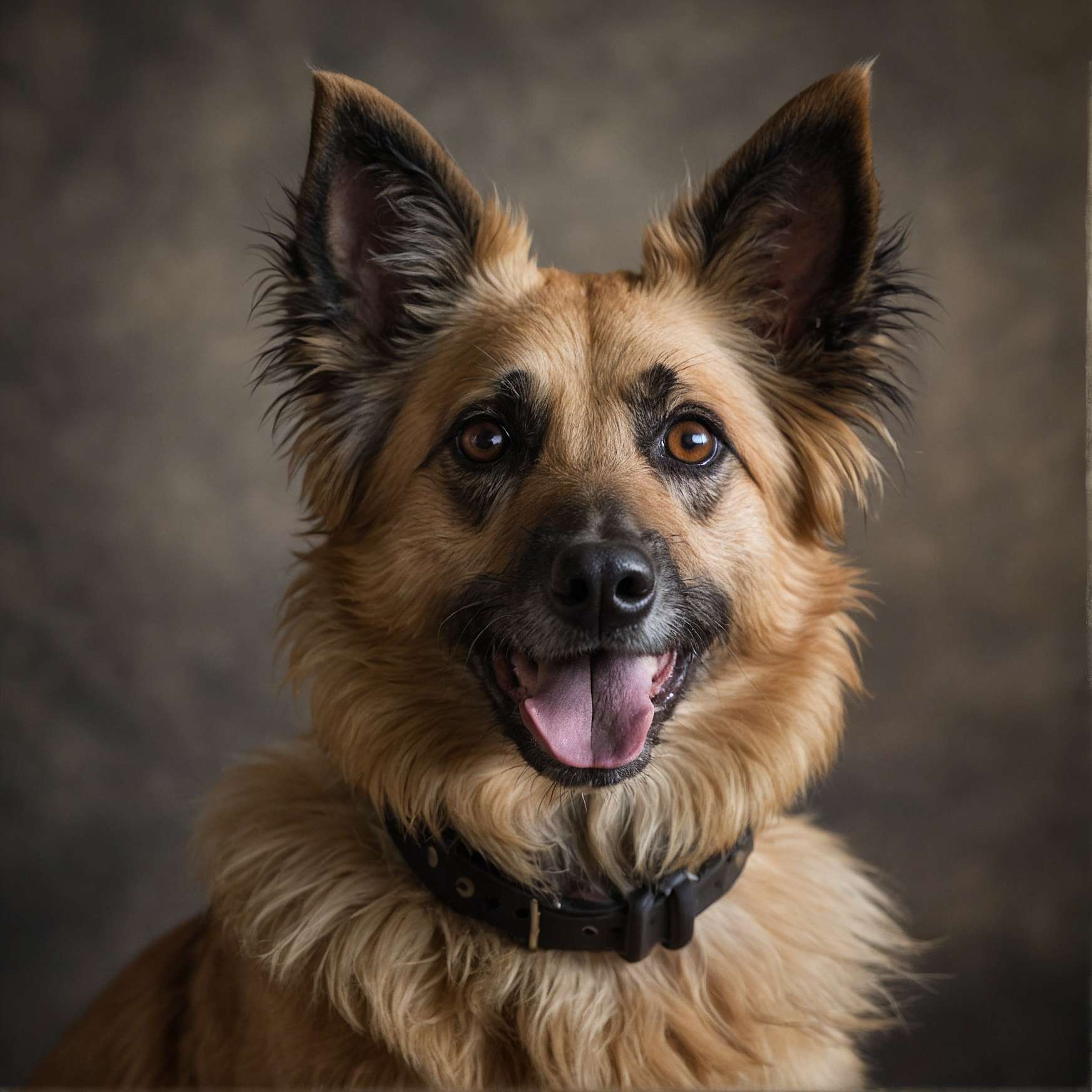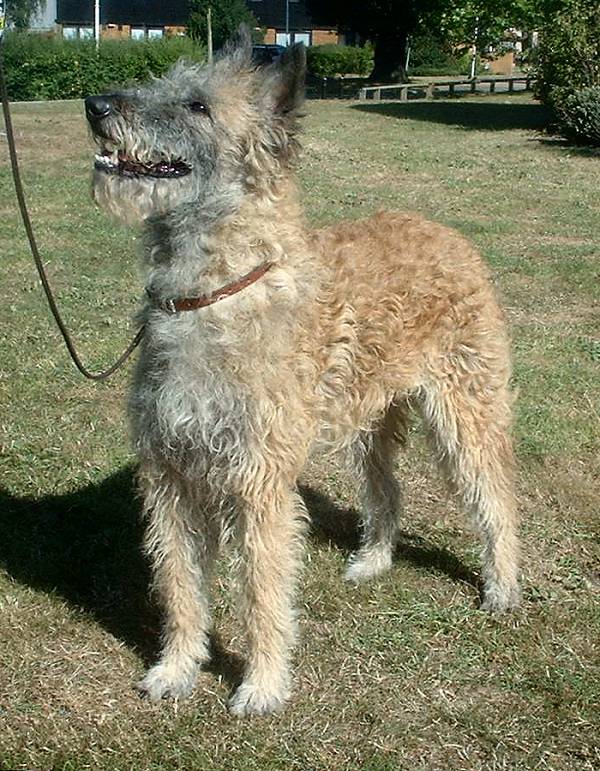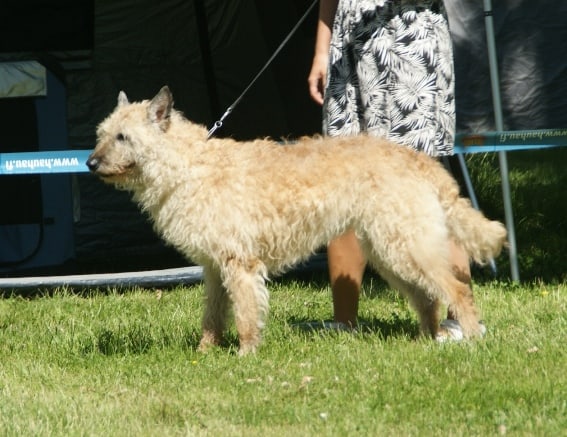The Belgian Laekenois, an embodiment of strength, unwavering loyalty, and versatility, has earned its place in the hearts of dog enthusiasts and professionals alike. With its Belgian origins, unique physical characteristics, and a wide range of temperament traits, this breed is esteemed as a dedicated working partner and loyal family companion.

| Category (Explanation) | Breed Information |
|---|---|
| Year of Breed Conception | 19th century |
| Country of Origin | Belgium |
| Weight (lbs & kg) (Male) | 55-65 lbs (25-29.5 kg) |
| Weight (lbs & kg) (Female) | 45-55 lbs (20-25 kg) |
| Coat Type | Rough double coat |
| Color Variations | Fawn with overlay |
| Shedding Level (Low, Moderate, High) | High |
| Height (cm & in) | 22-26 inches (56-66 cm) |
| Breed Size | Medium to large |
| Trainability (Low, Moderate, High) | High |
| Mental Needs (Low, Moderate, High) | High |
| Intelligence Level (Low, Moderate, High) | High |
| Energy Level (Low, Moderate, High) | High |
| Agility (Low, Moderate, High) | High |
| Loyalty (Low, Moderate, High) | High |
| Playfulness (Low, Moderate, High) | Moderate |
| Exercise Needs | Vigorous exercise and mental stimulation |
| Guarding Proficiency (Low, Moderate, High) | High |
| Sociability with Children (Low, Moderate, High) | Moderate |
| Barking Level (Low, Moderate, High) | Moderate |
| Digging Tendency (Low, Moderate, High) | Low |
| Destructive Behavior (Low, Moderate, High) | Low |
| Drooling Level (Low, Moderate, High) | Low |
| Obedience Level (Low, Moderate, High) | High |
| Apartment Friendly (Yes/No) | Can adapt to apartment living with sufficient exercise |
| Inherent Prey Drive | High |
| Physical Risk to Others (Low, Moderate, High) | Low |
| Travel Fatality Risk (Low, Moderate, High) | Low |
| Allergen Potential | Low |
| Health Concerns (List of Common Health Concerns) | Hip Dysplasia, Eye Issues, Epilepsy |
| Average Life Expectancy (Life Expectancy in Years) | 12-14 years |
Woof Mastery is reader supported and our articles may contain affiliate links.
Instead of running third party ads that we have no control of we only use links from high-quality companies we are directly partnered with. Making use of these links come at no cost to you our reader, and in many cases have the extra benefit of discounted rates or sign up bonuses.
If you’re interested you can read more about our affiliate policy here.
We appreciate your support and always insure that the products and services we recommend are high-quality, helpful and relevant to the subject at hand!
The Belgian Laekenois is one of the Belgian Shepherd breeds, known for its history of herding and versatile skills. These dogs hail from Belgium, where they were initially bred for herding duties.
Their name, “Laekenois,” pays homage to the Belgian town of Laeken, where the breed was developed. Belgian Laekenois dogs are characterized by their rugged and tousled appearance, which reflects their herding heritage.
Over time, they have demonstrated their intelligence and loyalty, excelling in herding, police work, and as devoted family pets. Their history is a testament to their enduring service to humanity.

The Belgian Laekenois is unique for its protective instincts and herding abilities. These dogs have a rich history of guarding and herding livestock. Their loyalty and courage make them exceptional working dogs and devoted companions.
Belgian Laekenois have a heritage as herding dogs in Belgium. Their agility, strength, and intelligence made them skilled herders, guiding and protecting livestock. They were known for their resilience and work ethic. Today, they participate in dog sports and continue to serve as herders, preserving their tradition as dependable working dogs.
Belgian Laekenois are celebrated for their protective and loyal personalities. They are known for their intelligence, courage, and herding abilities. These dogs have a history of guarding and herding livestock.
Their protective instincts and strength make them reliable working dogs, and their loyalty to their families is evident. Belgian Laekenois are characterized by their courage, devotion, and a strong sense of responsibility, epitomizing the ideal blend of loyalty and protection.
Belgian Laekenois are intelligent and protective. They are typically loyal to their families but can be reserved with strangers. Early socialization is important to ensure a balanced temperament.
They require mental and physical exercise to stay content.
Belgian Laekenois are medium-sized dogs with a well-proportioned and tousled appearance. They have a chiseled head with expressive almond-shaped eyes and slightly rounded ears.
They have a rough, wiry coat in a fawn color with black overlay. Their tail is often carried high.
Males typically stand between 24 to 26 inches (61-66 cm) at the shoulder and weigh between 55 to 75 pounds (25-34 kg), while females are slightly smaller and lighter.
Belgian Laekenois have a rugged and alert presence, reflecting their role as herding and working dogs.
Belgian Laekenois usually have a rough, tousled fawn coat with black overlay. They may not exhibit distinct coat colors.
Belgian Laekenois usually have a rough, tousled fawn coat with black overlay without distinct coat patterns.
Belgian Laekenois have a moderate shedding level. They shed throughout the year, with increased shedding during seasonal changes. Regular grooming and brushing are important to control shedding and maintain their coat.
Belgian Laekenois have a wiry, medium-length coat that requires regular grooming. Grooming habits for this breed include:
1. Brushing: Regular brushing, about once or twice a week, is essential to prevent matting and remove loose fur. Use a slicker brush or pin brush for grooming.
2. Bathing: Bathe Belgian Laekenois when necessary, using a dog-specific shampoo and thorough rinsing.
3. Ears: Check and clean their ears regularly with a veterinarian-recommended solution to prevent wax buildup or infections.
4. Nails: Trim their nails to a comfortable length to maintain proper gait and prevent discomfort.
5. Teeth: Brush their teeth regularly to ensure dental health and prevent bad breath. Dental chews or toys can be helpful.
6. Tail and Paw Care: Maintain cleanliness in the tail and paw areas, inspecting for any signs of irritation or injury.
Belgian Laekenois have a very high activity level and thrive on physical and mental challenges. Key points about their activity level include:
1. Exercise Needs: Belgian Laekenois require daily, vigorous exercise to stay content. Activities should be high-intensity and engaging.
2. Energy Level: They are known for their high energy levels, especially when young. Regular exercise is essential to prevent restlessness.
3. Herding Heritage: Historically, Belgian Laekenois were bred for herding livestock. They excel in activities like herding trials, agility, and obedience.
4. Mental Stimulation: In addition to physical exercise, mental challenges through obedience training and puzzle games are crucial.
5. Outdoor Enthusiasts: They enjoy outdoor activities and make great companions for those who enjoy hiking, running, and dog sports.
Pembroke Welsh Corgis are highly intelligent dogs known for their quick learning abilities. Here are some key points about their intelligence:
Pembroke Welsh Corgis’ intelligence and agility make them excellent companions and working dogs. Training, socialization, and mental stimulation are essential for their well-being.
Belgian Laekenois are highly intelligent and need constant mental stimulation. Engage them in obedience training, agility courses, and complex tasks to keep their minds active.
Social Interaction: They are social dogs and require regular interaction with their human family. Isolation can lead to anxiety and behavioral issues.
Exercise: Mental challenges are as important as physical exercise. Provide them with tasks that require problem-solving and focus.
Training and Obedience: Belgian Laekenois thrive on obedience training, which not only provides mental stimulation but also reinforces their bond with their owners. Consistency and positive reinforcement are essential.
Enter The Woof Mastery

Considering a Belgian Laekenois? Keep these points in mind:
1. Activity Level: Laekenois are active dogs that require regular exercise and mental stimulation.
2. Training Commitment: They are intelligent and need consistent training to prevent behavior issues.
3. Space: Laekenois need space to move around, making them better suited for homes with yards.
4. Shedding: Their double coat requires regular grooming to manage shedding and matting.
5. Work or Activities: Many Laekenois enjoy dog sports and tasks that engage their minds and bodies.
Belgian Laekenois, though not as large as some breeds, may pose a physical risk to others if not properly socialized, trained, or managed. The risk assessment factors include:
1. Protective Instinct: Belgian Laekenois may have a protective instinct, especially towards their family or territory. Proper training is essential to manage this instinct.
2. Socialization: Early and thorough socialization is crucial to ensure Belgian Laekenois are comfortable around people and other animals. Poor socialization can lead to fear or aggression.
3. Training: Obedience training is essential to teach Belgian Laekenois appropriate behavior and ensure they respond to commands. Well-trained dogs are less likely to engage in aggressive behavior.
4. Owner Responsibility: Responsible ownership involves being aware of the dog’s behavior and taking necessary precautions in public settings.
5. Breed-Specific Legislation (BSL): Belgian Laekenois may not be commonly subject to BSL, but owners should be aware of local regulations.
6. Individual Variability: Each dog is unique, and behavior can vary. Responsible ownership, proper training, and socialization are key to minimizing the potential physical risk to others.
Belgian Laekenois can be good with children, but their protective instincts may require supervision. They are loyal and may form strong bonds with kids. Early socialization is important to ensure they are well-adjusted around children.
Belgian Laekenois dogs can be good swimmers. Their strong and agile build is advantageous for swimming. Many may exhibit a natural instinct for it and enjoy being in the water. However, individual comfort levels with swimming can vary, so provide supervision and safety precautions.
Early and positive training will help your Belgian Laekenois puppy become a well-behaved and devoted companion.
Belgian Laekenois dogs are moderate in terms of noisiness. They may bark or use other vocalizations to alert their owners to unusual events, but they are not overly loud.
Belgian Laekenois thrive in homes that provide:
Challenges:
Traveling with Belgian Laekenois involves these considerations:
Belgian Laekenois are generally healthy, but they can be prone to certain health issues, including:
Proper nutrition is essential for Belgian Laekenois. Follow these nutritional habits:
Proper nutrition is essential for the health and well-being of Belgian Laekenois.
Breed-specific laws (BSL) may affect Belgian Laekenois in specific regions, and owners should be aware of these regulations. BSL is typically enacted at the local level, and the restrictions can vary from one jurisdiction to another. Here are some common types of BSL restrictions that Belgian Laekenois may encounter:
The rationale behind BSL is often based on concerns about public safety and perceived risks associated with specific breeds. While Belgian Laekenois are not inherently aggressive, they can be affected by BSL due to their physical resemblance to breeds sometimes included in these laws.
It’s important to note that BSL is a contentious topic, and many advocates argue that it unfairly targets breeds rather than addressing individual dog behavior. They emphasize that responsible ownership, training, and education should be emphasized instead of breed-specific restrictions.
To determine if there are breed-specific laws or restrictions regarding Belgian Laekenois in your area, you should check with your local animal control or government authorities. Be aware of and comply with any local regulations to ensure that you are in compliance with the law while owning a Belgian Laekenois.
Woof Mastery is reader supported and our articles may contain affiliate links.
Instead of running third party ads that we have no control of we only use links from high-quality companies we are directly partnered with. Making use of these links come at no cost to you our reader, and in many cases have the extra benefit of discounted rates or sign up bonuses.
If you’re interested you can read more about our affiliate policy here.
We appreciate your support and always insure that the products and services we recommend are high-quality, helpful and relevant to the subject at hand!
Myth 1: Belgian Laekenois are the Same as Belgian Malinois
Truth: Belgian Laekenois are a distinct Belgian Shepherd breed. They have their own unique characteristics and history.
Myth 2: They are Aggressive and Unpredictable
Truth: Proper training and socialization can lead to well-behaved and friendly Belgian Laekenois dogs. They are not inherently aggressive.
Belgian Laekenois dogs are a rare breed, and famous individuals of this breed may not be as well-documented. However, they are known for their loyalty and versatility in various roles, including herding, protection, and companionship.
Belgian Laekenois dogs have been cherished by owners who appreciate their rugged and versatile nature. Notable historical owners may not be widely recognized, but they have contributed to various working roles.
Belgian Laekenois, like all breeds, face certain challenges and dangers. Some of the greatest dangers and concerns for the breed include:
By understanding these challenges and providing responsible ownership and care, many of these dangers can be mitigated to ensure the well-being of Belgian Laekenois.
The Belgian Laekenois is one of the Belgian Shepherd breeds, along with the Malinois, Tervuren, and Groenendael. It was developed in Belgium for herding and livestock guarding. The breed’s history includes regional herding and working dogs selectively bred for specific traits required in their roles.
The Belgian Laekenois is a breed known for its rustic appearance and intelligence. They excel in various roles, from herding to obedience. Their affectionate nature and distinctive coat have made them beloved companions.
Being a Belgian Laekenois owner involves providing mental stimulation, exercise, and regular grooming. Responsible ownership includes addressing potential health concerns and nurturing their herding instincts through training.
With their tousled fawn coats and agile demeanor, Belgian Laekenois continue to charm those who appreciate their versatility and loyalty.